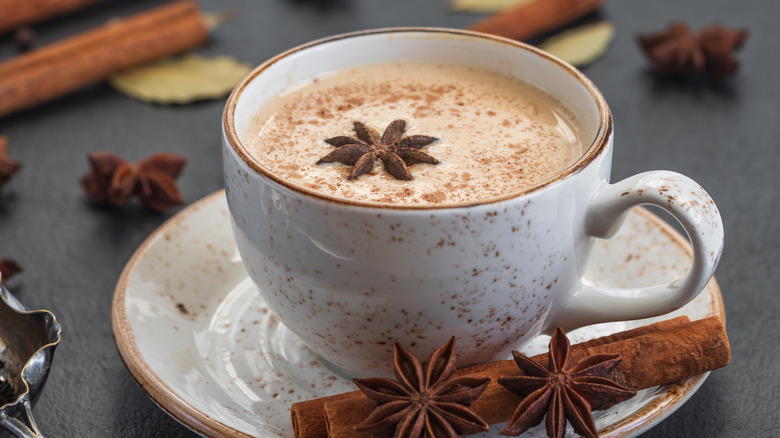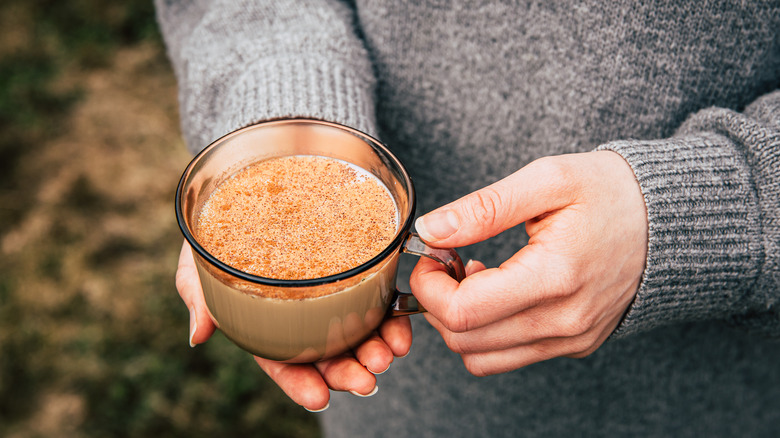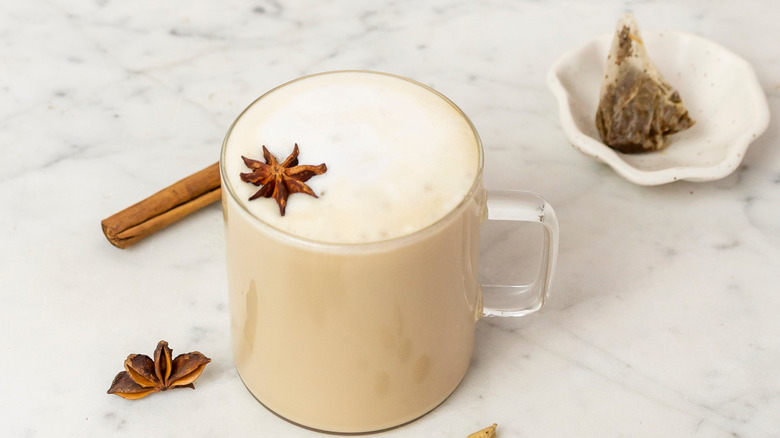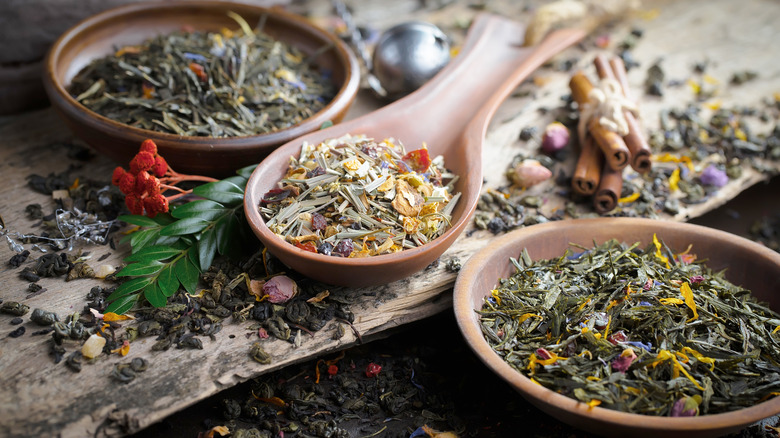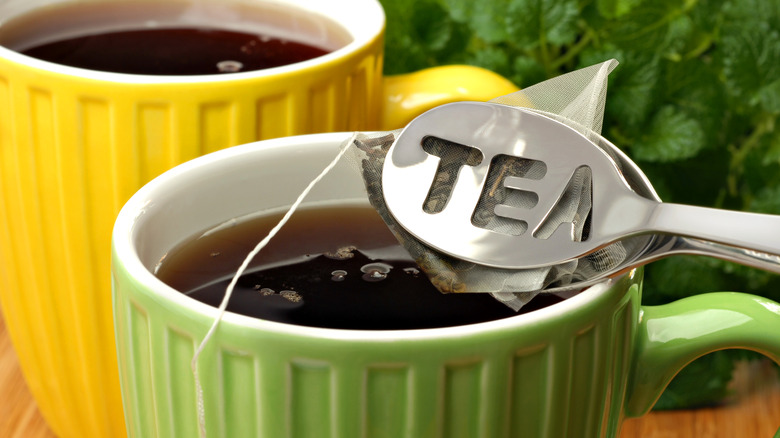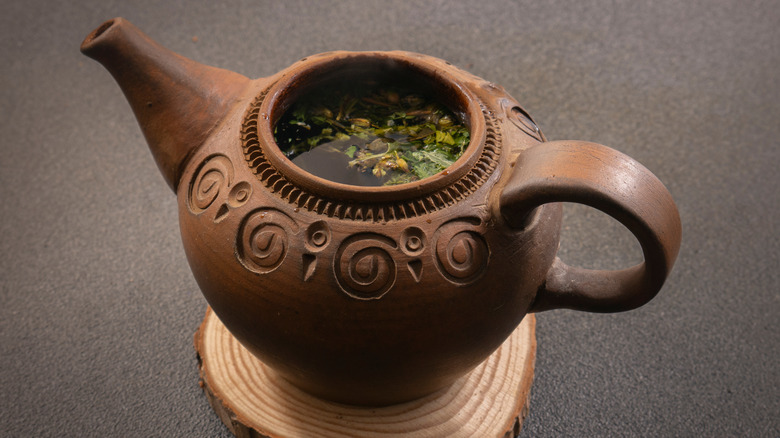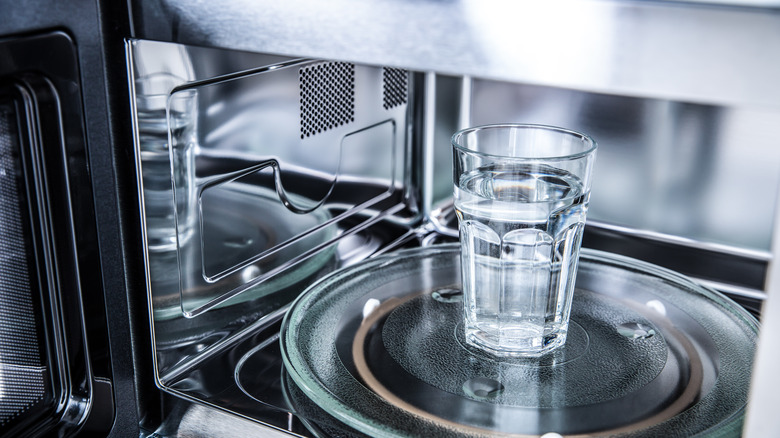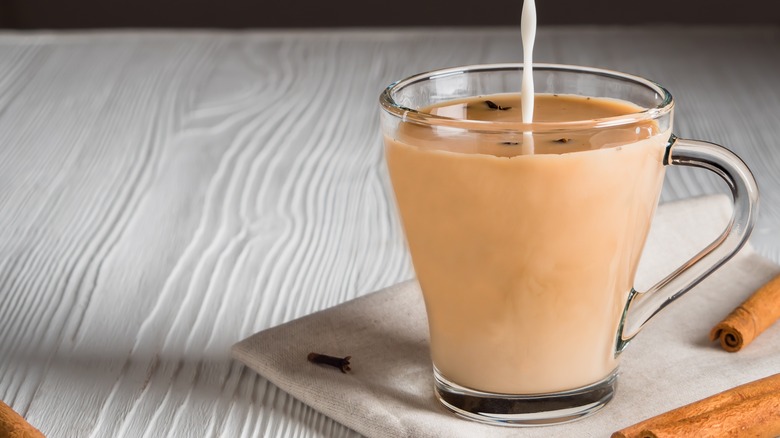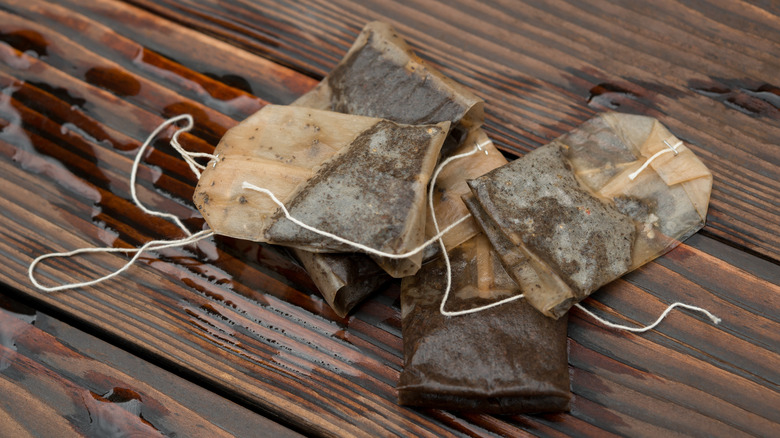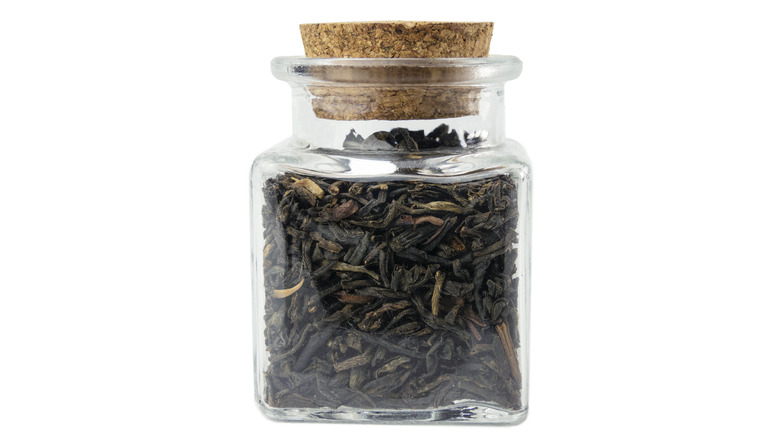Mistakes Everyone Makes When Making Chai Lattes
If "sugar and spice and all things nice" were to be encompassed in a hot beverage, masala chai would be it. Dating back 5,000 years, masala chai originated in India when a king ordered an Ayurvedic medicinal beverage. This resulted in a ginger, cinnamon, cardamom, and cloves spiced tea blend with each spice specifically chosen for its healing properties: ginger for digestion, cinnamon to aid circulation and the respiratory system, cardamom to support mood, and cloves to alleviate pain.
Unbeknownst to many contemporary masala chai drinkers, tea leaves were only added to masala chai thousands of years later. Today, it can be made using a variety of leaves including black, white, and rooibos tea, as well as yerba mate and Pu-Erh. In addition, it's more commonly consumed with hot milk. It's hard not to appreciate the comforting mix of milky sweetness and spice to enliven the senses when a cup of chai latte is being made at your favorite coffee shop. Sometimes though, you're the one in charge of that order in your kitchen. As with all things medicinal, chai is essentially a medicine and ritual, and without the needed awareness, many mistakes can be made. Read on to see what some of those are and what you can do to ensure your next chai latte is as "sugar and spice and all things nice" as can be.
Calling it chai tea
It's not unusual to see "chai tea latte" plastered across hot drinks menus in many a café or restaurant. In fact, there are several other popular name iterations for masala chai, such as chai, chai tea, and chai latte. However, according to Aura Chai, these names don't necessarily capture the essence of what this drink is. This is because the word "chai" directly translates to "tea" in Hindi, though it's often used in other cultures too, and "masala chai" directly translates to "spiced tea."
With the way marketing is set up, it may be difficult to kick the habit, but every time you're tempted to refer to your cuppa as "chai tea" or a "chai tea latte," remember that you'd essentially be calling it "tea tea" or "tea tea latte." Using the term "masala chai" is the gold standard; otherwise, opt for "spiced chai latte" or "masala chai latte." Though if we're being really honest, the gold standard is the simplest and easiest way to honor the cultures from which this delicious drink is derived.
Adding tea leaves or a tea bag too early
Most people simply place a tea bag in a cup, wait for the kettle to boil, and immediately pour the water over the tea bag as soon as the kettle clicks off. For those who are a little more particular or prefer tea leaves over bags, said leaves would usually go into a teapot and are then sloshed with freshly boiled water as soon as the kettle clicks off. According to Tea How, however, boiling hot water not only incinerates whatever benefits you were hoping to siphon from your tea, it'll likely have a negative impact on the flavor.
As such, it's worth noting that the water temperature for black and Pu-Erh tea should be at 205 degrees Fahrenheit (195 degrees Fahrenheit if you're using raw Pu-Erh), 185 degrees Fahrenheit for darjeeling, and 175 Fahrenheit for white tea. What's more, per Art of Tea, making the perfect cup of tea extends beyond the leaves and the temperature of the water you use. When you're making your masala chai, the type of tea you use will have its own steep time. For instance, black and Pu-Erh tea need to steep for three to five minutes, darjeeling needs only three minutes, while white tea can be ready in one to three minutes.
Using stale tea leaves
Yes, there absolutely is such a thing as stale tea leaves. Given that the leaves in both tea bags and loose leaf teas are already dry, you may be wondering how they could possibly be stale. Per Dominion Tea, preserving the quality — and taste — of your tea all comes down to storage. In the meantime, however, there are several methods you can use to ascertain whether or not your tea is still in tip-top shape.
Black tea is the popular tea of choice for masala chai, and while it can hold its flavor for longer than other types of tea, its changes are also the most subtle when it has gone stale. What you want to look out for is for a lingering bite and stale bread taste to the tea. In addition, tea that has gone stale will be darker when brewed, and may also have a flat taste or tastes like paper. If your masala chai is a pre-made blend, the spices will be your best clue; if the blend starts to taste weird or otherwise just weak, you know it's passed its prime. In fact, it's specifically recommended that you consume your masala chai blend within a year of the purchase in order to yield its best health and flavor benefits.
Squeezing the tea bag
Many of us are guilty of this: If the color of the tea is not changing fast enough, you use the teaspoon to hold the tea bag in a chokehold against the cup. Per Ringtons, regardless of what tea you're making — and the longstanding debate about whether or not you should — there's a science behind not squeezing the tea bag. Tea leaves, like many fruits and vegetables, contain a micronutrient called polyphenols. However, this micronutrient is especially high in tea leaves because of the high amounts of tannic acid that are found in tea.
The underbelly of higher levels of tannic acid is a higher risk of bitterness. Here's where it gets even more crucial: Whatever liquid that's left inside a tea bag once the tea has steeped contains significantly higher levels of tannic acid than what escaped during the steeping itself. As such, when you squeeze the bag, you actually release some of that tannic acid that was initially trapped in the tea bag, leaving you with a tea that is a whole lot more bitter and acidic than it needed to be. So the next time you're tempted to go for that teaspoon chokehold, remember that leaving it be for an extra minute or two will make your cup far more pleasant.
Taking the lid off your teapot while it's brewing
Another detail that many people either do not give much thought or are quite particular about is whether or not you should take the lid off your teapot while it's brewing. According to TeaMinded, while covering herbal teas while they steep is a crucial part of preserving the essential oil contained therein, for others, such as black tea, covering while it steeps is a useful way of keeping the water at the intended temperature while the tea steeps.
So once you've gone through the effort of matching the specific tea you're using for your masala chai to its specified water temperature, the last thing you want is to lose it all during the steeping process. If you're making only a single cup or do not have a teapot, you can place a saucer or mug cover over the cup. If you generally like to leave the tea bag in the cup while drinking, just bear in mind that it will keep steeping, which will likely have an impact on the flavor of your tea.
Using tap water or water that's been microwaved or reheated
Firstly, this is a judgment-free zone. Because even the best among us have been tempted or, at the very least, thought about using microwaved, reheated, or hot tap water. Nevertheless, according to Mashable, there's a science behind why microwaving water for your tea is so uncouth. The cited study indicates that water boiled in the kettle or on a stovetop essentially goes through a convection process, thus heating it evenly, while the microwave heats from various angles simultaneously, thus offering no promise of an even boil — you'll know this too if you've defrosted meat in the microwave and had some parts cooked while others are still frozen.
Reboiled and tap water, on the other hand, are not so much about being uncouth as it is about your health. According to Healthy Holistic Living, the first boil serves as a great way to dissolve harmful compounds in the water — hence it's always advised to boil water when in doubt about whether it's safe to drink. When it's then left to sit and then reboiled though, those compounds concentrate and may become even more harmful than they initially were. The main concern with tap water is that over time the metal parts of water systems corrode, and as hot water transports contaminants from these parts much faster (via Denver Water), your risk of ingesting said contaminants is much higher.
Not knowing when to add the milk
Milk before water, water before tea ... it is a longstanding debate that may possibly never know any end. That being said, according to The Guardian, science dictates that milk goes first. The reason: when milk is poured into the cup after the hot water, it's said to heat unevenly, which, in turn, causes the milk proteins to disintegrate, resulting in that wonky skin on top of your tea.
Further, per Heart, by pouring the milk into the cup first and thus preserving the integrity of the milk proteins, you inadvertently also lock in the flavor of the tea. This is because the tannins — which give the tea its flavor — stay malleable to releasing flavor, rather than becoming solid, as is the case when hot water is added first. It's not clear where in this debate masala chai falls, but ultimately, it's worth knowing how you can optimize its flavors the next time you're making a cup.
Not reusing or recycling used chai leaves
Did you know that you can reuse and recycle your masala chai leaves? According to The Indian Express, there are many ways to continue reaping their benefits beyond your warming cuppa. For one, you can add more water to the steeped leaves once your masala chai is ready, allow it to cool while you enjoy your cup, and thereafter, strain it and use it as a hair conditioner. Note: you might want to use a dark towel to dry your hair in case it stains.
If you're a natural detergents enthusiast — or looking for a way to get started — you can rinse your used chai leaves, boil them in fresh water, strain, and leave to cool. Once cooled, pour the liquid into a spray bottle and use it to disinfect surfaces and to clean mirrors, crockery, and wooden furniture. Other uses include using the steeped leaves as a fertilizer for your plants, particularly roses as the tannic acid contributes to higher acidity in the soil and thus higher quality. Once dried, steeped leaves can also be placed in your kitchen cabinets or the refrigerator to keep them smelling good — just remember to replace them as needed.
Not storing tea leaves and tea bags well
As previously noted, preserving the quality of your tea leaves and bags is all about your storage practices. According to Tea Epicure, there are six key things to keep in mind about storing tea. If you've ever wondered why some bags of tea leaves come vacuum-sealed, the answer is oxygen — when exposed, the leaves will keep oxidizing, which will stale them faster, so you want to ensure that you're storing your tea in airtight containers. You should keep your tea away from heat as this will prevent condensation.
While scientific evidence has yet to be provided, its been purported that exposure to light may cause some kind of chemical changes in your tea leaves — take this at your own discretion. You want to keep it away from strong smells and moisture as it can absorb odors, while moisture will release some of its flavor even before you've decided to steep it yourself. Generally, you want to store you tea leaves in airtight containers, and even better, in bulk, as this is more likely to reduce those little air pockets that occur as just a consequence of having spaces and crannies between leaves.
